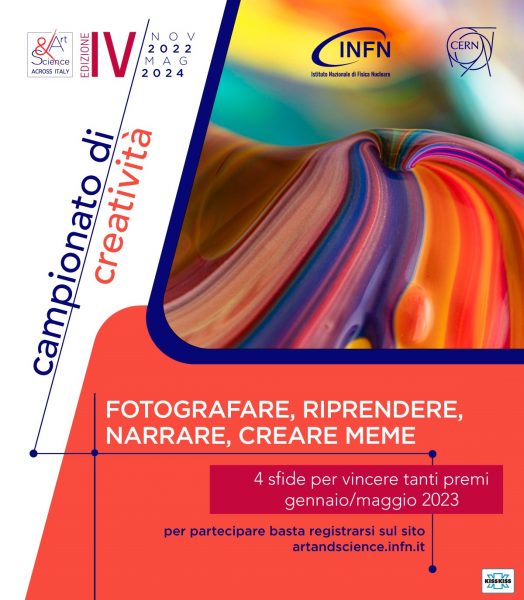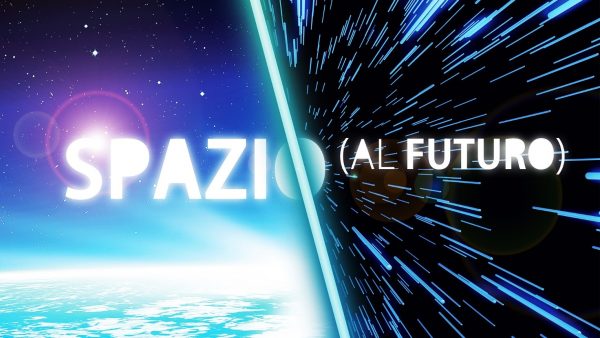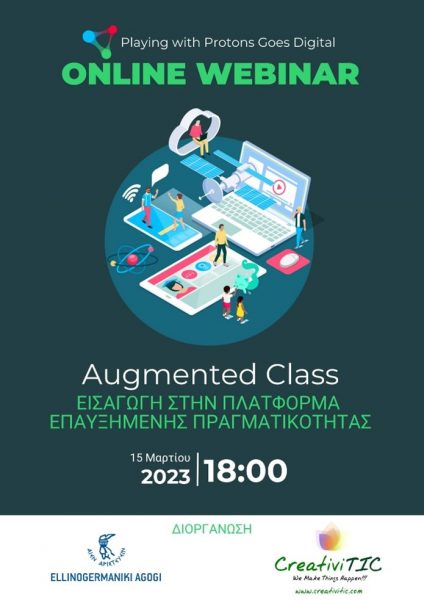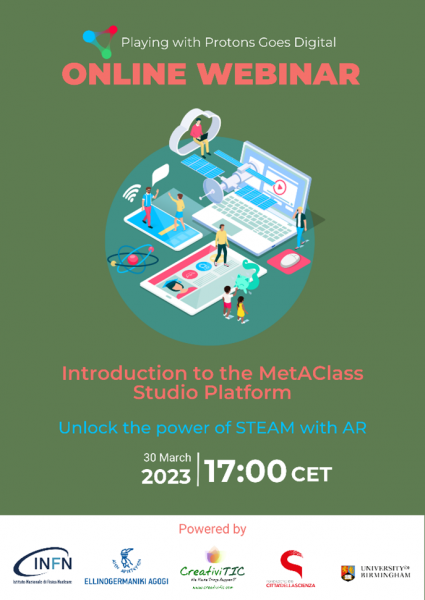News & Events
Newsletter #3
02/05/2023
Welcome To Our Newsletter #3
Welcome to the February 2023 newsletter of the Playing with Protons Goes Digital project!
As we have been progressing with the project, we are enthusiastic about the appreciation and the results obtained so far. Many teachers participate in our training activities, showing a growing interest and willingness to try out our approach and methodology with their students.
In this issue:
- Art & Science Across Italy edition 2022 – 2023
- Augmented Reality Platform is available: create your own lesson proposal from Città della Scienza
- Exhibition on Space at Città della Scienza
- Playing with protons on line webinar
We hope you enjoy reading our newsletter and invite you to check our website regularly, follow us on social media. And please feel free to get in touch with out national contacts in Greece, Italy, Spain, and the UK for bringing Playing with Protons Goes Digital to your school classroom.
- Art & Science Across Italy edition
Art & Science across Italy – IV edition
The IV edition of the Art & Science across Italy project started in December 2022. More then 6.000 students (15-17 years old) from 127 Italian secondary schools have joined the project.
During the first year (January-May 2023) the students are invited to attend five national online seminars (https://artandscience.infn.it/calendario-attivita-nazionali-2022-2024/), all the regional activities proposed by the 120 INFN researchers and take part in the “Creativity Championship”.

The regional activities are usually science seminars at school, visit at science and art museums and visit at INFN/University laboratories.
The championship is preparatory to the realization of the artworks of the second year. It is a way to train the students in the complicated process of synthesizing a scientific concept with an artwork and consists of four matches with which the students are invited to describe a scientific topic, chosen between the three proposed, using four different forms of art: photograph, video, story-telling and comic strips, or meme.
The five best ranked students at the end of the four matches will be awarded in a public ceremony.
- The AR Platform
The Playing with Protons Goes Digital AR Platform is a game-changer for teachers and educators looking to create innovative STEAM educational content. Powered by MetAClass Studio, the platform enables teachers to take abstract concepts and bring them to life in a way that is both visually stimulating and engaging for students. By creating interactive and immersive experiences, the platform allows learners to explore and interact with complex scientific ideas in a way that was never before possible.
With the AR platform, you can:
- design AR experiences that simulate real-world phenomena
- manipulate objects in 3D space, all in real-time
- personalize learning experiences to help students overcome learning barriers, motivate them to learn, and improve their understanding of challenging topics
- create a rich and dynamic learning environment that sparks students’ curiosity, and creativity, and fosters their passion for science.
Proposal about Climate change in Art. It’s an activity based on art study to engage students on big problem of the today society, like climate change. Students can carry out the same work on other scientific topics and integrate laboratory activities. For example, for climate change, below is an abstract of a workshop on climate. Students could create similar work by choosing a work theme and searching for artists’ images that depict significant aspects of the chosen study/work theme. The teachers could integrate with the carrying out of laboratory activities on the chosen topic and organise a presentation or handout on the work done which will be presented in a public event with the participation of stekolders from the education, art, and school sectors.

Artwork by Olafur Eliassaon in collaboration with the geologist Minik Rosing, created for the 2015 Paris COP. It includes 12 pieces of ice extracted in Greenland arranged in a circle outside the Panthéon square. Installation has been defined as “beautiful and disturbing”.
that would have been right to not extract ice from Greenland, which of course is already reducing as well as to increase CO2 pollution to transport it from Greenland to Italy, negatively affecting the Greenhouse effect! I could have avoided all this by using augmented reality!
All together! The world of ants at Città della Scienza Museum. The activity is meant for primary and middle school pupils visiting the exhibition about ants as social insects with their teachers. The experience is divided into two stages: the first involves a training meeting for teachers so that they are better informed of the experience that their pupils are going to carry out; the second is the actual activity that involves the pupils. For 75-90 minutes, pupils listen to the guide, observe and sometimes even touch the insects, observe models and watch videos. They also need to answer the questions and complete tasks in a special notebook. At the end of the activity, they talk about their experience with insects and what they have learned. Learning about the behaviour of social insects, pupils get introduced to topics from biology, zoology, ethology and ecology. Tasks and questions in the notebook are specially designed for the age range of the participants with some reference to the curriculum in natural science in school. This way the activity connects learning in formal and informal settings. This activity mainly contributes to sparkle students’ interest to science and developing their understanding of social animals, with a bit less contribution to developing scientific reasoning and reflection. This fits IDIS profile as a science museum with their priorities in terms of contribution to science proficiency being developing interest to science, engaging in scientific reasoning and understanding scientific content.
This is the true activity where the pupils will carry out a guided exploration in an exhibition showing real anthills of different species of ants.
- Spazio al Futuro the new exhibition on space at Città della Scienza
How does the Universe work?
What physical laws do we know that govern its functioning?
Does the Universe really expand and what does the expansion of the Universe mean?
By moving his hands in and out of one of the interactive exhibits on display, the visitor will be able to travel through time on a cosmic scale: moving his hands closer together will ‘compress’ the Universe until the hands of the cosmic clock reach the Big Bang. Turning them away will be enough to start its expansion.
What do we know about the most fascinating objects in the Universe, the black holes? Here too, it will be possible to find out through an interactive installation and virtually experience the impossible of approaching even a black hole. But gravity also acts on a smaller scale on the various bodies that populate the Universe: it will be possible to experience its effects by simulating a walk on Mars or the Moon.

The exhibition Space (to the Future) will thus take the public on a journey through past, present and future, with the contribution of science fiction, through that gaze that since antiquity human beings have turned towards the heavens with the desire to discover the secrets of the Universe in which they are immersed.
- Playing with Protons go Digital online webinar
On 𝟭𝟱 𝗠𝗮𝗿𝗰𝗵 𝟮𝟬𝟮𝟯
OUR 𝗳𝗶𝗿𝘀𝘁 𝗼𝗻𝗹𝗶𝗻𝗲 𝘄𝗲𝗯𝗶𝗻𝗮𝗿 aimed at teachers to learn how to 𝗰𝗿𝗲𝗮𝘁𝗲 𝗼𝗿𝗶𝗴𝗶𝗻𝗮𝗹 𝗮𝗻𝗱 𝗰𝗮𝗽𝘁𝗶𝘃𝗮𝘁𝗶𝗻𝗴 𝗲𝗱𝘂𝗰𝗮𝘁𝗶𝗼𝗻𝗮𝗹 𝗺𝗮𝘁𝗲𝗿𝗶𝗮𝗹 𝘂𝘀𝗶𝗻𝗴 𝗔𝗥?
Our Greek Partner Ellinogermaniki Agogi in collaboration with the spanish one CreativiTIC offer you the opportunity to visualize complex scientific ideas in a way that has never been possible before.

SAVE THE DATE > 30 𝗠𝗮𝗿𝗰𝗵 𝟮𝟬𝟮𝟯
A practical webinar to explore the full potential of teaching with #augmentedreality!
Our AR platform created by CreativiTIC is a powerful tool that will help you create awesome projects and engage your students like never before!
- Register here: https://bit.ly/40rrP6Y

